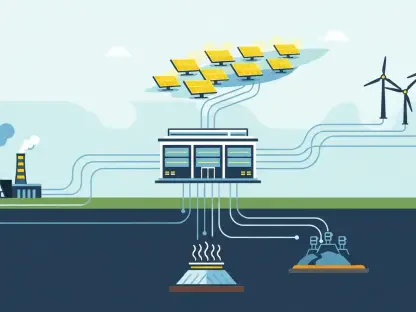In the heart of the Scottish Highlands, a quiet revolution is transforming the energy landscape as grid-scale battery technology takes center stage in stabilizing power supply amid a surge in renewable energy adoption. At Blackhillock, Europe’s largest lithium battery storage facility hums with potential, delivering not just power but a promise of a zero-carbon future. With a capacity of 200 MW, this site stands as a beacon of innovation, addressing the critical challenge of maintaining grid frequency and voltage in a world increasingly reliant on wind and solar. This development sparks curiosity about how technology can bridge the gap left by traditional fossil fuel generators and whether Scotland’s pioneering efforts can light the way for global energy systems.
Overview of Grid-Scale Battery Technology in Scotland
Grid-scale batteries have emerged as a cornerstone of modern energy systems, particularly in regions like Scotland where renewable energy sources dominate the power mix. These systems store excess energy during periods of high generation and release it during demand spikes, ensuring a stable supply despite the intermittent nature of renewables. Their role extends beyond mere storage, acting as a buffer against rapid frequency fluctuations that threaten grid reliability, a challenge that has grown with the decline of coal and gas plants.
The Blackhillock site exemplifies this technological leap, representing a significant milestone as Europe’s largest lithium battery storage facility. Operated by Zenobē, in collaboration with SMA Solar Technology, this installation has demonstrated its capacity to enhance grid stability by responding to sudden power shortfalls within milliseconds. Its impact is profound, offering a glimpse into how large-scale storage can replace the inertia once provided by the spinning rotors of traditional generators.
Technological advancements, particularly grid-forming inverters, underpin this transformation. Unlike conventional inverters that follow grid conditions, grid-forming units operate autonomously, simulating inertia and managing frequency drops with precision. This innovation aligns with the UK’s ambitious zero-carbon energy goals, driving investments and policy support for such projects as a means to ensure a sustainable and resilient power infrastructure.
Current Trends and Market Dynamics in Grid Stability Solutions
Emerging Technologies and Industry Shifts
The integration of renewable energy into national grids has accelerated, creating an urgent need for advanced stability solutions. As wind and solar power contribute a larger share of electricity, their inherent variability poses risks to grid balance, necessitating technologies that can respond swiftly to disruptions. Scotland, with its heavy reliance on renewables, stands at the forefront of this shift, adopting cutting-edge systems to maintain power quality.
A notable industry shift is the transition from fossil fuel generators to grid-forming inverters, which replicate the stabilizing effects of traditional systems. These inverters manage frequency fluctuations by injecting power on demand, a capability proven during sudden generator failures in the region. This move reflects a broader trend toward digital and electronic solutions over mechanical ones, reshaping how grids are managed.
Consumer and industry demand for sustainable energy further fuels this evolution, creating fertile ground for battery storage systems. Businesses and households alike prioritize green solutions, pushing utilities to invest in technologies that reduce carbon footprints. This growing preference opens significant opportunities for grid-scale batteries, positioning them as a dual-purpose asset for both stability and environmental progress.
Market Performance and Growth Projections
Economically, grid-scale batteries promise substantial benefits, with Zenobē projecting consumer savings of £309 million over a 15-year span starting from this year. These savings stem from reduced renewable energy curtailment and enhanced grid efficiency, lowering operational costs passed on to end users. Such figures underscore the financial viability of these systems beyond their technical merits.
Growth indicators for grid-scale battery adoption in Scotland and the wider UK point to robust expansion, driven by the push for renewable integration. Market analyses suggest a steady increase in deployment over the coming years, with capacity expected to rise significantly by 2027. This trajectory aligns with national targets for decarbonization, cementing batteries as a critical component of energy policy.
Looking globally, Scotland’s pioneering role offers a scalable model for other regions. As countries grapple with similar transitions, the success of projects like Blackhillock could inspire widespread adoption, potentially transforming energy markets worldwide. The convergence of economic incentives and technological readiness suggests a bright future for this sector on an international scale.
Challenges in Deploying Grid-Scale Battery Systems
Implementing grid-scale battery systems is not without hurdles, particularly on the technical front. One pressing issue is the limitation of power electronics in delivering short-circuit current during grid faults, a function crucial for maintaining voltage and triggering protective relays. Current designs, while innovative, face constraints due to heat buildup, which risks damaging components under high stress.
Additionally, the reliability of grid-forming inverters remains untested in real-world fault scenarios, raising concerns among experts. While simulations and controlled tests show promise, the response of transmission relays to digitally managed current surges is uncertain, posing potential risks to grid safety. This gap in proven performance necessitates cautious deployment strategies.
Economic and operational challenges also loom large, with high initial installation costs deterring some stakeholders. Strategic grid planning is essential to optimize placement and capacity, adding complexity to rollout efforts. To address these issues, a balanced approach incorporating synchronous condensers as redundancy alongside batteries could mitigate risks, ensuring stability while technology matures.
Regulatory Framework and Compliance in Grid Stability Tech
The regulatory landscape in the UK shapes the development of grid stability technologies, with the National Energy System Operator (NESO) setting stringent mandates. These guidelines prioritize outcomes like frequency control and short-circuit current provision, pushing developers to innovate within defined safety and performance parameters. Compliance with such standards is non-negotiable for market entry.
Specific requirements, such as the ability to supply short-circuit current, directly influence technology design, as seen in the Blackhillock project’s inverter capabilities. NESO’s focus on these critical functions ensures that new systems can safeguard grid integrity during faults, aligning with broader reliability goals. This regulatory clarity drives consistent advancements across the sector.
NESO’s procurement strategy stands out for its emphasis on outcomes rather than specific equipment, encouraging creative solutions. This flexibility fosters a competitive environment where diverse technologies can emerge, benefiting the industry as a whole. Such an approach not only supports current stability needs but also aligns with the national vision of a zero-carbon grid, reinforcing sustainable practices through policy.
Future Outlook for Grid-Scale Batteries and Renewable Integration
Grid-forming batteries hold transformative potential for global energy systems, offering a blueprint for decarbonization. Their ability to stabilize grids while supporting renewable integration positions them as a scalable solution for regions transitioning from fossil fuels. Scotland’s success could catalyze similar initiatives worldwide, reshaping power distribution norms.
Innovations in power electronics are poised to address existing limitations, such as heat constraints during high-current delivery. Research into enhanced cooling mechanisms and transistor durability promises to elevate inverter performance, potentially eliminating current bottlenecks. These advancements could redefine the capabilities of grid-scale storage in the near term.
Market disruptors, including shifting consumer preferences for green energy and fluctuating global economic conditions, will influence adoption rates. As demand for sustainable power grows, alongside potential cost reductions in battery technology, the pace of deployment may accelerate. NESO’s ongoing efforts to showcase fossil-free grid operation serve as a benchmark, highlighting the path forward for scalability and impact.
Conclusion and Strategic Recommendations
Reflecting on the strides made, the Blackhillock grid-scale battery project marks a turning point in stabilizing Scotland’s power supply while advancing renewable energy integration. Its deployment showcases the power of technology to address long-standing grid challenges, delivering both economic savings and environmental gains. The initiative proves that innovative solutions can bridge critical gaps in energy infrastructure.
Moving forward, stakeholders should prioritize sustained investment in grid-forming technology to refine its reliability and efficiency. A balanced strategy, integrating traditional stability mechanisms like synchronous condensers, emerges as a prudent step to manage risks during this transitional phase. Additionally, fostering international collaboration to share lessons from Scotland’s experience could accelerate global progress toward cleaner energy systems, ensuring that this pioneering effort lays the foundation for broader transformation.









